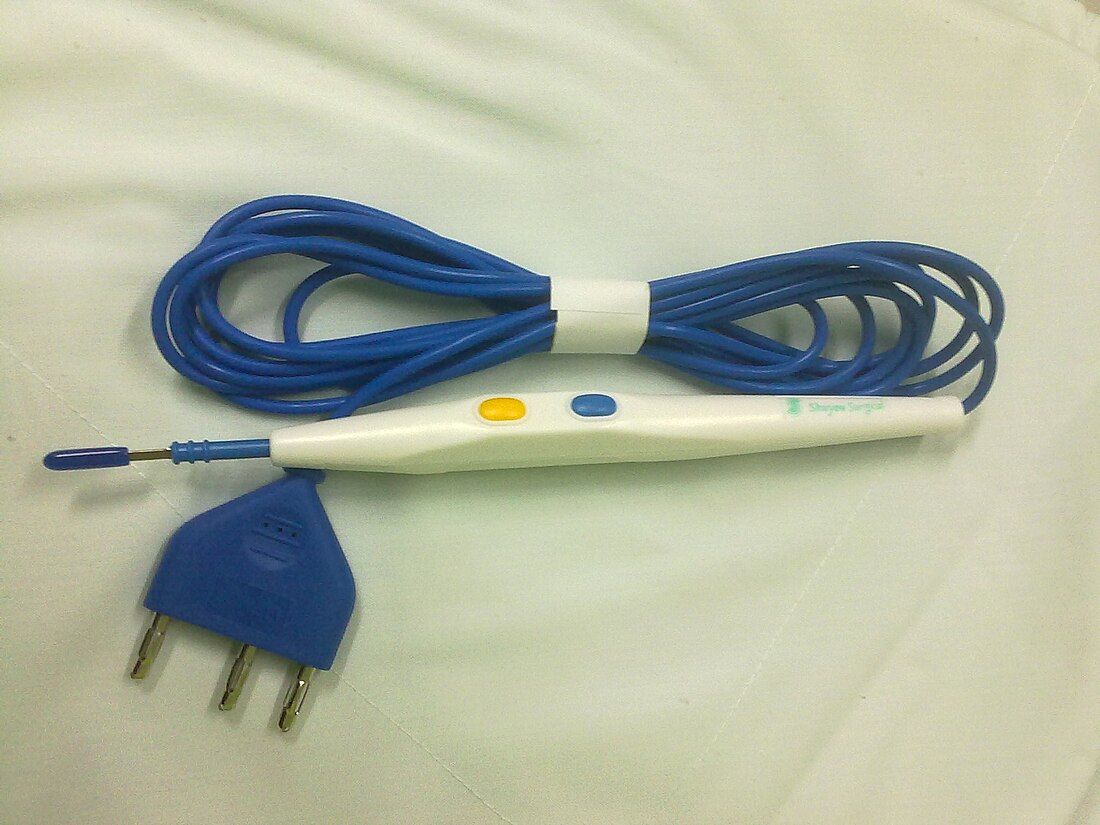Instruments used in general surgery
From Wikipedia, the free encyclopedia
There are many different surgical specialties, some of which require specific kinds of surgical instruments to perform.
General surgery is a specialty focused on the abdomen; the thyroid gland; diseases involving skin, breasts, and various soft tissues; trauma; peripheral vascular disease; hernias; and endoscopic procedures.
Instruments can be classified in many ways, but, broadly speaking, there are five kinds of instruments.
- Cutting and dissecting instruments
- Grasping or holding instruments
- Hemostatic instruments
- Retractors
- Tissue unifying instruments and materials
Instruments used in surgery are:[1][2][3][4][5][6][7][8][9][10][11][excessive citations]
| Instrument Name | Image | Brief description | Specific instruments |
|---|---|---|---|
| Electrical cautery |  |
Electrical surgical cauterization utilizes electricity in either a monopolar or bipolar format to burn soft tissue and control bleeding[12] |
|
| Curette |  |
For scraping or debriding biological tissue or debris in a biopsy, excision, or cleaning procedure | |
| Dermatome |  |
Removes epidermis to graft over another area | |
| Dissecting forceps |  |
Grasping and holding; usually used in skin closures or small wounds | Adson |
| Tissue forceps |  |
Grasping and holding tissue | Allis |
| Penetrating towel clamp |  |
Used to secure towels or reduce bone fragments | Backhaus penetating towel clamp |
| Carmalt forceps | Hemostatic forceps | Kalabasa | |
| Cushing forceps | Grasping and holding | Non-toothed dissecting forceps | |
| Dandy forceps | Hemostatic forceps | ||
| DeBakey forceps |  |
Grasping and holding | Non-toothed dissecting forceps designed for use on blood vessels, organs, or delicate tissue |
| Doyen intestinal clamp | Clamps and distractors | Non-crushing clamp designed for use on the intestines | |
| Kelly forceps |  |
Hemostatic forceps | |
| Kocher forceps |  |
Hemostatic forceps | |
| Mosquito forceps |  |
Hemostatic forceps | |
| Hook | Retractor | ||
| Nerve hook | Retractor | ||
| Skin hook | Retractor | ||
| Lancet (scalpel) |  |
Cutting | |
| Mammotome |  |
||
| Needle holder |  |
Grasping and holding |
|
| Retractor |  |
Retractor | Handheld:
Self-retaining:
|
| Ultrasonic scalpel | Cutting | ||
| Laser scalpel |  |
Cutting | |
| Scissors |  |
Cutting and spreading | May be curved or straight |
| Speculum |  |
Used to retract orifices |
|
| Suction tube and Yankeur suction tip |  |
Accessories and implants | |
| Surgical elevator |  |
||
| Surgical hook |  |
Retractor | |
| Surgical blade #15 |  |
Used to cut vessels or make small incisions | |
| Surgical mesh |  |
Accessories and implants | |
| Surgical needle |  |
Accessories and implants | |
| Surgical sponge | |||
| GIA stapler |  |
Used to make a gastrointestinal anastamosis | Linear stapler |
| Surgical tray | |||
| Suture |  |
||
| Tongue depressor |  |
||
| Tonsillotome | |||
| Towel clamp |  |
Clamp | |
| Towel forceps | Clamp | ||
| Backhaus towel forceps |  |
||
| Lorna towel clamp | Non-penatrating towel clamp | ||
| Tracheotome | |||
| Tissue expander | Accessories and implant | ||
| Subcutaneous inflatable balloon expander | Accessories and implants | ||
| Trephine |  |
Cutting instrument | |
| Trocar |  |
Access instrument. Used to create an opening into a space without opening the abdominal cavity. A camera is inserted through one to view the interior while instruments are inserted through the others to manipulate the organs. | |
| Ultrasonic energy device | Surgical device typically used to dissect tissue, but also seals small vessels and tissue bundles |
References
Wikiwand - on
Seamless Wikipedia browsing. On steroids.
